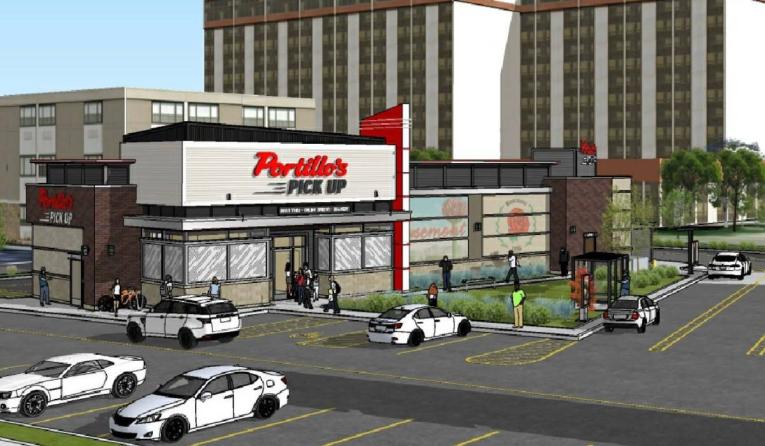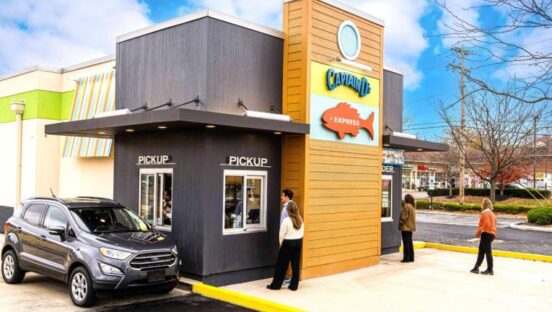One modern marketing strategy tells companies to “meet customers where they are.” That could be amended in the limited-service restaurant industry to “meet customers where they drive.”
As the percentage of customers using drive-thru lanes at quick-service and fast-casual restaurants has grown, an increasing number of dining brands of all sizes have considered—and gone forward with—launching drive-thru-centric units, many with pickup options.
Even before COVID-19 hit in 2020, operators were looking beyond the rising number of consumers using drive-thrus to a variety of other issues, including higher costs for labor, construction, energy, and real estate, as well as diners’ move toward digital ordering.
That activity accelerated during the pandemic, as many restaurants became essentially drive-thru-only units because their dining rooms were closed for weeks at a time. Operators found they could still be profitable by having drive-thrus, pickup options, and delivery options alone.
The increased push for drive-thru and pickup-only stores “was definitely driven by COVID,” says Maeve Webster, president of Vermont-based foodservice consultant Menu Matters. While off-premises visits have dipped some since, “they are still higher than pre-pandemic.”
READ MORE: Dive into the 2023 QSR Drive-Thru Report
It makes sense for operators to look at the drive-thru-only option due to the potential “enormous number of efficiencies and benefits” that such a move could provide, she notes. These range from requiring a smaller footprint to improved speed of service.
The challenge with drive-thru and pickup-only locations is for companies to avoid relegating these units solely to providing customers with “transactional events,” not a brand connection, Webster states. Otherwise, the stores become “nothing more than large vending machines.”
Still, there are logical sites for these units, she adds, especially as fill-in locations between a company’s regular restaurants and in high-density urban areas with expensive real estate and where customers are seeking a quick meal to eat while traveling or to take to the home or office.
Several companies are doing exactly that, dipping their toe into the drive-thru-only pool with a handful of initial units and plans to add more. Many require less than an acre of land, fewer employees, and various cost savings, albeit with lower sales numbers than dine-in ones.
Jack in the Box Inc., based in San Diego, is adding drive-thru-centric units at both its namesake and Del Taco brands. At this point Jack in the Box has two of the restaurants open with about a half-dozen more in development, while Del Taco has one with more on the drawing board.
The company has stated the initial Jack in the Box off-premises prototype in Tulsa, Oklahoma, is outperforming expectations. “I was just at a franchise convention, and there’s a lot of energy around this,” says Van Ingram, vice president of franchise development for both brands.
“The concept is to have a smaller, really efficient footprint for a higher volume, so there are multiple pickup and convenience” avenues, he notes. Units feature a Y-lane drive-thru, walk-up window for ordering, and a pickup area for mobile and third-party delivery orders.
In designing the off-premises prototype, the company built it by integrating its kitchen with key components like the safety of employees, how to get food in the customers’ hands quickly, making pickup easier for third-party delivery, and reducing build-out costs by some 20 percent.
With that in hand, the question then became “What is the smallest footprint that meets all these considerations?” Ingram recalls. The answer was 1,375 square feet, with a few parking spaces for employees and delivery drivers, who pick up orders in lockers just inside the building, rather than being delayed by customers—or alternately delaying other customers—in the drive-thru.
The drive-thru and walk-up units are among several venue options at both Jack in the Box and Del Taco, providing flexibility in the size of the eateries to meet the markets where they are being built. The smaller stores “allows us to look at niche markets where we couldn’t before,” he says, including both urban and suburban sites with high real-estate costs.
Del Taco’s first drive-thru and pickup-only unit, part of its “Fresh Flex” store offerings, is about 100 square feet smaller than its sister company’s non-dine-in restaurants and features pickup lockers that are built into the restaurants’ façade. The interest in pickup options shows that “[Quick-service] is probably taking some learning from what fast casual has done,” Ingram adds.
Both brands are looking at their early units to determine how to move forward with them. For instance, the Tulsa eatery’s industrial image has been changed in the second store.
To differentiate themselves from their traditional locations, some companies have provided drive-thru-centric units with new surnames. One favorite is “Express.”
Captain D’s is among those, as it already has three Express locations open and a fourth slated for the first quarter of 2024. With buildings of about 970 square feet on sites as small as four-tenths of an acre, these spots join the company’s 22- and 44-seat restaurants—emphasizing the latter.

The idea of using drive-thru-centric stores in busy, urban markets is also the logic at Chicago-based Portillo’s, which is expected to open its second Portillo’s Pick Up in suburban Rosemont.
“Prior to COVID, we had determined that we wanted to be in more urban metropolitan areas that are population dense,” says Brad Reed, chief development officer of the Nashville, Tennessee-based entity. When the pandemic hit, “We thought this was something that could really work.”
Considerable research went into determining what Captain D’s wanted to accomplish with the new units, which would have fewer sales without dine-in business but also less labor requirements and build-out costs. “Then we had to be creative with the kitchen size,” Reed says.
The initial prototype, which costs up to $300,000 less to develop than the brand’s large dine-in restaurants, featured a revamped kitchen built for speedy service, a smaller menu than dine-in, a drive-thru lane, far fewer parking spaces, and ordering and pickup windows.
“We’ve been pleased with their performance,” Reed states. Still, the company has made a few tweaks in the design after the first two stores opened, including moving some equipment around and adding a second drive-thru lane in new units to help improve speed and flow.
In addition, the menu was expanded to include more items Captain D’s offers elsewhere. “Our guests really like the variety, so we went in and added more” options, he points out. “In looking back, we went too far in scaling back.”
Plans call for two to three Express locations—combined company- and franchise-owned—to open annually going forward. Captain D’s plans, however, to focus more on dine-in locations, especially in smaller towns, where the restaurants are often strong casual-dining options.
North Carolina-based Biscuitville also has dubbed its drive-thru-only spots Express. The units are about 1,800 square feet—more than a third smaller than full-size ones—and feature two order lanes that merge into one pay lane plus a walk-up window with a couple of outside tables.
“Before COVID, we were doing approximately 70 percent [of sales] through the drive-thrus,” states Blake Jennings, chief development officer. “Post-COVID it’s been about 80 percent. Because of that, it made sense to test drive-thru-only units.”
The first Biscuitville Express was a conversion in its hometown of Greensboro, North Carolina, while the initial new build is in nearby Burlington. The plan for now is that the drive-thru-centric stores will be in urban markets that already have several dine-in locations.
“This will help us grow because of additional site availability,” he says, explaining that the Express locales require just seven-tenths of an acre, about half that of a regular unit. Not only are the buildings smaller, but less space is needed for parking.
The drive-thru-only units are expected to result in a 15 percent development cost savings per unit, including construction and equipment, such as one fewer HVAC unit and restroom. Operationally, “we will be able to manage labor better,” Jennings notes, plus kitchen efficiencies.
“We’re looking at a one-to-two-year horizon to tell how successful these will be,” he adds, but “sales preliminarily look like we will be happy.”
The idea of using drive-thru-centric stores in busy, urban markets is also the logic at Chicago-based Portillo’s, which is expected to open its second Portillo’s Pick Up in suburban Rosemont. The first came online in Joliet, Illinois.
“In markets that begin to mature, conventional sites could be seen as cannibalizing,” says Derrick Pratt, chief operating officer. “We see this as in-fill that is perfect for smaller sites along busy travel corridors,” the executive adds.
The name for the new units emphasizes their multichannel off-premises focus.
“We operate third-party pickup, independent guest, and catering delivery [in addition to a three-lane drive-thru],” he states. “The only channel we’re not operating there is dine-in.” Online orders are picked up on inside shelves.


The unique drive-thru is something that evolved as the company evaluated the first unit’s performance. Two lanes will be for full orders, while drivers with orders that can be filled quickly will be directed to a third lane. As at other Portillo’s, the company retains its industry innovative use of employees standing by menu boards to take orders and payment.
“We consider the middle lane as an express lane,” Pratt says. “Say if someone orders a piece of cake, they would be sent to that lane, and someone could run [the item] out in 30 seconds.”
Portillo’s Pick Up locations are built on less than half the real estate for a conventional dine-in restaurant, even with the third lane. Construction and equipment costs are considerably lower, and the return on investment is “accretive,” he notes.
While most companies are looking at the drive-thru-only units for urban locations, Taco John’s is going another direction. The Cheyenne, Wyoming-headquartered chain is eying small towns with fewer than 10,000 residents for its smaller, less expensive Drive-Thru Olé outlets.
“Our focus has always been small markets,” notably in the upper Midwest, says Brooks Speirs, vice president of franchise development. Many markets are underserved and “This is a great option for people there, and a good opportunity for franchisees to get a return on investment.”
The Drive-Thru Olés, built with customized modular pieces on less than a half-acre of land, cost roughly half of a traditional Taco John’s 38-seat dine-in restaurant, he notes. That means they can be nicely profitable, even with projected sales of 80 percent of the larger units.
Construction time is also shortened, because the modular pieces—Taco John’s originally built modular style—can be fabricated while site preparation is going on. The modular pieces are shipped to the restaurant location and can be put together in a few days.
With two of these eateries already open—the first in South Dakota in 2021—and another two projected to open early in 2024, the company has gathered valuable insights. It’s learned from some design issues and made several improvements, particularly regarding the kitchen line in the original design.
“If you look at the upper Midwest, we think there are 30 small locations, where there is already one competitor, to build smaller units,” Speirs states. And there is potential to put some in newer urban areas, like Boston, but those likely would need to have in-store pickup space.









